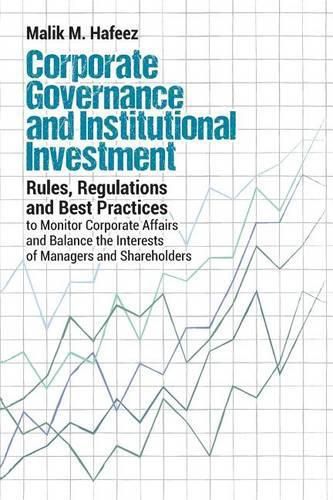Readings Newsletter
Become a Readings Member to make your shopping experience even easier.
Sign in or sign up for free!
You’re not far away from qualifying for FREE standard shipping within Australia
You’ve qualified for FREE standard shipping within Australia
The cart is loading…






This title is printed to order. This book may have been self-published. If so, we cannot guarantee the quality of the content. In the main most books will have gone through the editing process however some may not. We therefore suggest that you be aware of this before ordering this book. If in doubt check either the author or publisher’s details as we are unable to accept any returns unless they are faulty. Please contact us if you have any questions.
Corporate Governance and Institutional Investment focuses on corporate governance and the legal nature of institutional investors in the corporate system. Its aim is to expose the complexity of the relationships that exist between companies on one side, and their shareholders, stakeholders, and monitors on the other. Various types of investors, including trusts and companies, are discussed, including how they function under different legal guidelines. The role of investment managers acting on the behalf of institutional investors is examined, as well as why fund managers overlook the corporate governance problems of their investee’s companies when they are performing well financially. This complexity is one of the main reasons why corporate scandals still occur, despite the existence of an extensive academic literature on corporate governance and the sustained efforts by the corporate community around the world. An analysis of how the monitoring role of institutional investors became effective in the light of company law and trusts is presented by using a comparative model involving the U.K., the U.S.A., Pakistan, and continental Europe. Financial scandals of the last decade such as Enron, Northern Rock, and the banking crisis are also examined. Finally, a review of regulatory approaches which rely upon formal rules and institutions backed by the state legal system, and non-regulatory approaches emphasizing the market mechanism and contractual arrangements, is included.
$9.00 standard shipping within Australia
FREE standard shipping within Australia for orders over $100.00
Express & International shipping calculated at checkout
This title is printed to order. This book may have been self-published. If so, we cannot guarantee the quality of the content. In the main most books will have gone through the editing process however some may not. We therefore suggest that you be aware of this before ordering this book. If in doubt check either the author or publisher’s details as we are unable to accept any returns unless they are faulty. Please contact us if you have any questions.
Corporate Governance and Institutional Investment focuses on corporate governance and the legal nature of institutional investors in the corporate system. Its aim is to expose the complexity of the relationships that exist between companies on one side, and their shareholders, stakeholders, and monitors on the other. Various types of investors, including trusts and companies, are discussed, including how they function under different legal guidelines. The role of investment managers acting on the behalf of institutional investors is examined, as well as why fund managers overlook the corporate governance problems of their investee’s companies when they are performing well financially. This complexity is one of the main reasons why corporate scandals still occur, despite the existence of an extensive academic literature on corporate governance and the sustained efforts by the corporate community around the world. An analysis of how the monitoring role of institutional investors became effective in the light of company law and trusts is presented by using a comparative model involving the U.K., the U.S.A., Pakistan, and continental Europe. Financial scandals of the last decade such as Enron, Northern Rock, and the banking crisis are also examined. Finally, a review of regulatory approaches which rely upon formal rules and institutions backed by the state legal system, and non-regulatory approaches emphasizing the market mechanism and contractual arrangements, is included.